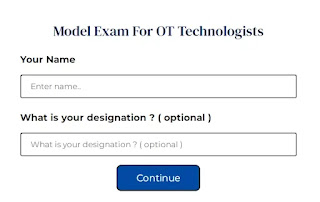Operation Theatre Technologist Guide . In this blog i upload study material for operation theatre technicians , anesthesia technicians , scrub nurse , ot attendants and many more .
Quiz for OT Technician | Model Paper 1 ( Total MCQs 30 )
Topics from where MCQs are made
- 1. Regional anesthesia
- 2. Drugs used in regional anesthesia
- 3. Spinal, caudal and epidural anesthesia
- 4. Anesthesia for common surgical procedures
- 5. Anesthesia for co-existing diseases
- 6. Pt in shock and cardiac arrest
- 7. Anesthesia in special situation
- 8. Complication in anesthesia
- 9. Basic principles of blood transfusion
- 10. Basic principles of fluid management
- 11. Ventilators
- 12. Intensive coronary care unit
- 13. Pain management
- 14. CPR
- 1. Physics applied to anesthesia fundamental concept in systemic
- international unit (SI unit).temp conversion, pressure measurement,
- pressure gauges, regulators, gas laws, misc. concepts such as density and
- specific gravity
- 2. Medical gases color coding of anesthetic gases, diff size of cylinders e.g.
- A to E cylinders storage of cylinder diameter index safety system, medical
- gas pipeline system and station outlets air compressors 02 concentrators
- alarm and safety devices
- 3. Gas administration devices simple 02 administration devices reducing
- valve flowmeters regulators
- 4. 02 therapy
- Definition of hypoxemia..Clinical signs goals of O2 therapy evaluation
- of pt. Receiving O2 therapy hazards of O2
- therapy
- 5. Humidification its goals and advantages
- Types of humidifiers possible causes of retention of secretions in airway
- And management
- 6. Aerosol therapy; definition , goals ,hazards, assessment, aerosol therapy in
- lung disease
- 7. Anesthesia system; machine, Boyle’s anesthesia machine basic principles
- of anesthesia machine
- 8. Respiratory gas analyzers(o2 and co2)
- Definition, classification, uses of pulse oximeters, capnographs, and
- transcutaneous oxygen monitors
- 9. Manual resuscitators
- Types of resuscitator bags indications methods of increasing oxygen
- delivery while using oxygen with resuscitation bags
- 10. Airways management with use of gadgets
- Types and sizes of oropharyngeal airways, indications and complications
- types and sizes of nasopharyngeal airways, indications, and complications
- parts of airway and features and methods of insertion orotracheal
- intubation: types of orotracheal tubes, indications and complication
- nasotracheal intubation types of nasotracheal tubes, indications and
- complication
- 11. Sterilization of anesthesia equipment
- Cleaning of anesthesia equipment methods of autoclaving, boiling,
- pasteurization, gamma radiation, chemical sterilization etc. sterilization of
- syringes needles, spinal and epidural sets, airways, Magill forceps,
- laryngoscope etc.
- 12. History of anesthesia
- Prehistoric era inhalational anesthetics era regional anesthetic era
- intravenous anesthetic era modern anesthetic era
- 13. Pre-operative preparation a. pre anesthetic assessment.
- History of present illness. Past history of anaesthesia, smoking, alcohol
- etc. personal history of the patient General physical examination: Vital
- signs, general appearance, anemia, etc., systemic examination: Cardio
- vascular system, respiratory system, per abdominal, central nervous etc.
- local examination example : ulcers, swelling etc.
- B. Investigations.
- Hematology – complete haemogram, Urine – complete urine analysis
- Biochemistry – blood glucose, urea and creatinine special investigations
- related to disease of the patients Electro cardio gram chest X ray
- C. Criteria used of r accepting the case for anaesthesia
- D. Pre anesthetic order
- E. Checking the machine, laryngoscopes, tubes, airways etc. Suction
- apparatus, oxygen cylinder, anesthetic drugs and emergency drugs
- 14. Intra operative management.
- Confirm the identity of the patient monitoring system (Harvard Medical
- school standards) induction – Drugs used during induction of anaesthesia
- Endotracheal intubation, confirming the tube position and securing the
- tube. Maintenance of anaesthesia Fluid/ blood and electrolyte balance
- reversal from anaesthesia – drugs used transferring the patient recovery
- room monitoring the patient, suction apparatus, oxygen resources,
- anesthetic drugs and emergency drugs for resuscitation.
- 15. Anaesthesia
- 1. Principles of pediatric anaesthesia management of neonatal surgical
- emergencies, RA in infants
- 2. Associated medical disorders in surgical patients anaesthesia implications
- and management
- 3. Basics of orthopedic anaesthesia.
- 4. Day care anesthesia.
- 5. Rural anaesthesia – anaesthesia for camp surgery.
- 6. Anaesthesia for otorhinolaryngology with special emphasis on difficult
- airway management
- 7. Blood and blood component therapy. Anesthetic implications in
- coagulation disorders.
- 8. Monitored anaesthesia care.
- 9. Anaesthesia implication in diabetic mellitus thyroid and parathyroid
- disorders. phaeochromocytoma, cushings disease etc.
- 10. Management of acid base disorders.
- 11. Principles of geriatric anaesthesia.
- 12. Anesthesia outside the OR and in special situation
 |
| Quiz for OT Technician | Model Paper 1 |
Recommended Topics
Label List
- BASIC CONCEPTS (19)
- ANESTHESIA EQUIPMENTS (18)
- Exam (13)
- study material (12)
- MCQ FOR OT TECHNICIANS (11)
- ANESTHESIA PREPRATION (10)
- DEVICES USED IN OT (7)
- random topics (7)
- CSSD & OTHER DEVICES (6)
- FIND A JOB (5)
- QUESTION PAPERS (5)
- latest updates (4)
- DRUGS (3)
- PATIENT CARE (3)
- Registration (3)
- Surgical Instruments (3)
- History of Anesthesia (2)
- by - Ritika Sharma (1)

Post a Comment
Post a Comment